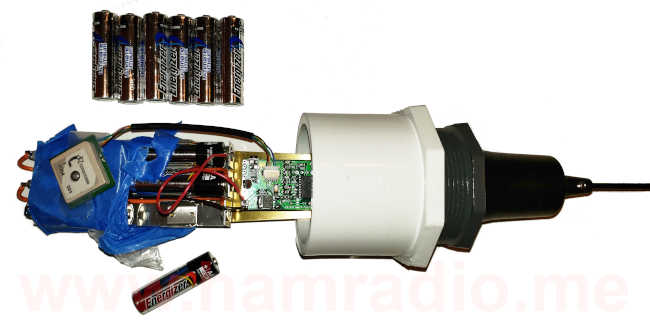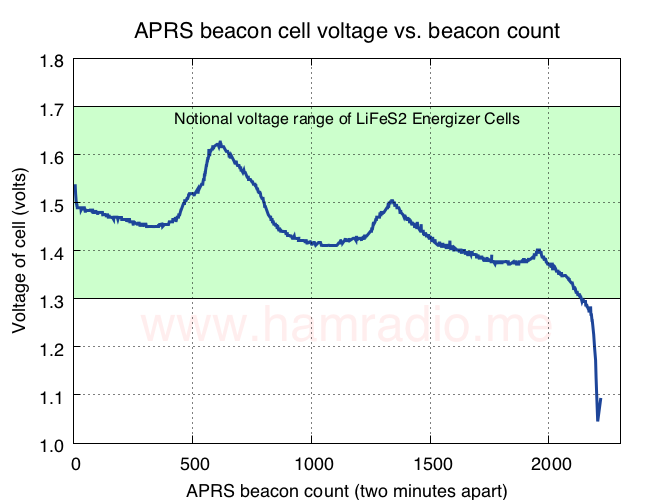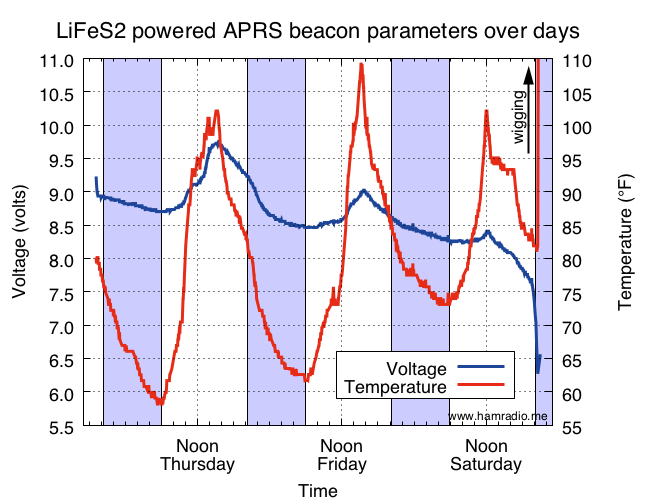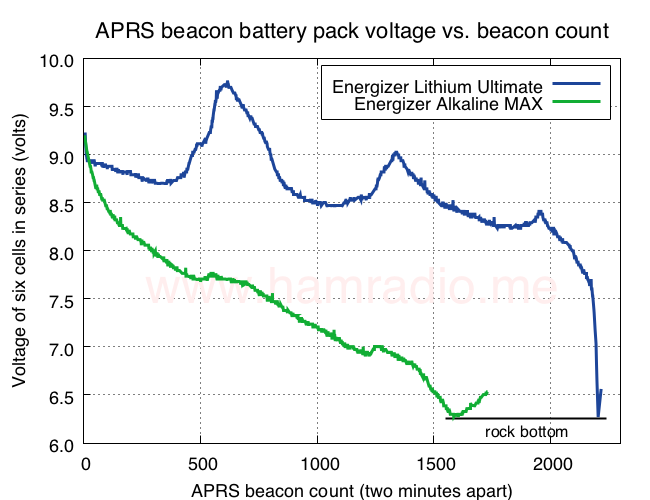A power source to go the distance
In preparation for an upcoming public service event we decided to make good use of Bob Bruninga’s Hike Across Maryland APRS technique to monitor the drag horse riders’ position as they make their way through many miles of trails in the back woods along the WV/VA line. One of the events will be a full 24 hours in length. I need a battery system that will power the APRS transmitter well beyond that time. I put together a prototype of a stow-ready APRS beacon with a six AA cell battery holder wired in series.
APRS beacon power requirements
The beacon is the MT-2001 model from Byonics and is seen fitted into this portable beacon I’m prototyping.

A six AA cell holder, wrapped in all that blue painters tape, powers the Byonics MT-2001. It transmits one APRS beacon every two minutes (adjustable) with a current requirement of about 800 milliamps for about 1/2 a second. Standby of the transmitter and companion GPS receiver is about 70 milliamps. Much less than a lot, but a touch more than a little. Portable power to go the distance while fitting into a packable form needs thought and, especially, verification before the event.
Energizer Lithium Ultimate AA cells
I ordered 24 AA Lithium cells from McMaster-Carr (much cheaper than most any local price, but that’s changing fast it seems) and placed six into the beacon battery holder. The unit came to life and was placed outside in various locations, back packed a bit, strapped to the John Deere, etc. The unit performs exceptionally well thanks to its full size, 1/2 wave antenna. Of the over two thousand APRS beacons transmitted, about half made their way to APRS-IS via the obviously well engineered W4KEL-12 digipeater/I-Gate 49 miles away. Needless to say, the portable beacon design works quite well as does W4KEL-12.
How the Energizer Lithium Ultimate batteries performed
Figure 2 shows the voltage reported by the APRS transmitter normalized to the cell voltage by dividing by six.

The Lithiums held their own quite well over three full days.
It’s important to understand the graphs above and below are made only from data that the beacon transmitted with sufficient strength to reach the distant digipeater. This is only really important when the cells reach end of charge, but still have just enough energy to transmit a useful signal.
Voltage vs. temperature of Energizer Lithium Ultimate AA batteries
We can explain the wide fluctuations in voltage over time by considering figure 3 that compares the above with temperature data… also transmitted by the MT-2001.

It’s quite clear temperature has a large effect on Lithium batteries in this configuration. It was pretty hot out. The blue regions highlight nighttime to correlate with the temperature variations.
Just after sunset on Saturday the Energizer lithiums finally gave out, The APRS transmitter reported some erroneous temperature readings. Not a surprise and entirely well within acceptable behavior of a failing power rail.
The batteries far exceeded the 24 hour requirement by a factor of 3x. Needless to say I’m quite pleased with this result.
What about Energizer Alkaline AA cells?
It was too good to pass up testing the exact same APRS beacon with fresh Energizer MAX AA cells. Though a bit less expensive than the Lithiums, can they provide enough performance to avoid the need for them? Figure 4 compares the results of the first and second tests.

Key points include:
- The alkaline cell’s voltage profile is quite different than the lithiums, but still provide more than enough voltage to operate the beacon electronics for well over two days. They pass the test for this particular event.
- Alkaline cells show a similar dependence on heat (temperature not shown above), but much more subdued.
- Lithium cells show the trademark holding of voltage till the bitter end and then falling quick while the alkaline cells have a steady decline over time.
- As in figure 2, when the pack voltage reaches about 6.3 volts, the APRS telemetry values start to wig out even while still managing to transmit a beacon to the distant digipeater.
Why the difference between alkaline and lithium?
The information by the makers of the Energizer batteries suggest the AA cell holds around 2-3000 mA-hours of energy. How much of that is available to the end user depends on cell chemistry and how it’s used. An alkaline battery apparently provides the full energy capacity at only very low current draw while severely increasing over time its internal resistance with higher power loads. In contrast, the lithium cell delivers almost all its energy in this test’s varying load.
Cold weather performance?
It’s well into Spring here in Virginia so no cold testing possible. From what I’ve read the lithiums hold up much better than the alkaline cells in colder temperatures. If the test occurred in January, I have little doubt figure 4 would show an easy win for the lithium cells.
Thoughts
If you shop wisely, Energizer MAX (Alkaline) AA cells are available for about $1 each and the Lithium Ultimates for about $2.25 (although I just saw an 8-pack at Wal-Mart for $10!). Seems almost too good to be true. Is lithium worth the extra $1.25 (if you avoid Wal-Mart)? In warm temperatures probably not. Probably so in cold months. They key to success for either cell in this safety application is to ensure your supply of cells is fresh with full energy capacity. If you cannot figure out when you purchased that handful of AA cells you found in the drawer and need to count on them, better to move the mystery batteries to the bin marked for low energy applications like TV remotes, etc.
An important alleged feature in the Energizer Lithium cells is built-in current limitation at high temperatures. This is good short circuit protection that alkaline cells do not seem to provide. I’ve seen alkaline cells melt the insulation off wiring and send smoke to the heavens. Hence, this is not something to take lightly.
Conclusion
With the better performance, growing availability and waning price of Energizer Lithium Ultimate cells, I’m beginning to sense the era of the alkaline power cell is in end stage. For this APRS beacon, I’ll stick with Energizer Lithium cells since I already have them. It’s nice to know the alkaline cells will work in a pinch however.
I put Energizer Lithium AA batteries in my smoke detectors over 2 years ago and they're still working great. I love that I don't need to change them as often as alkaline batteries.
By the way, Amazon currently has an 8-pack for $9.49.